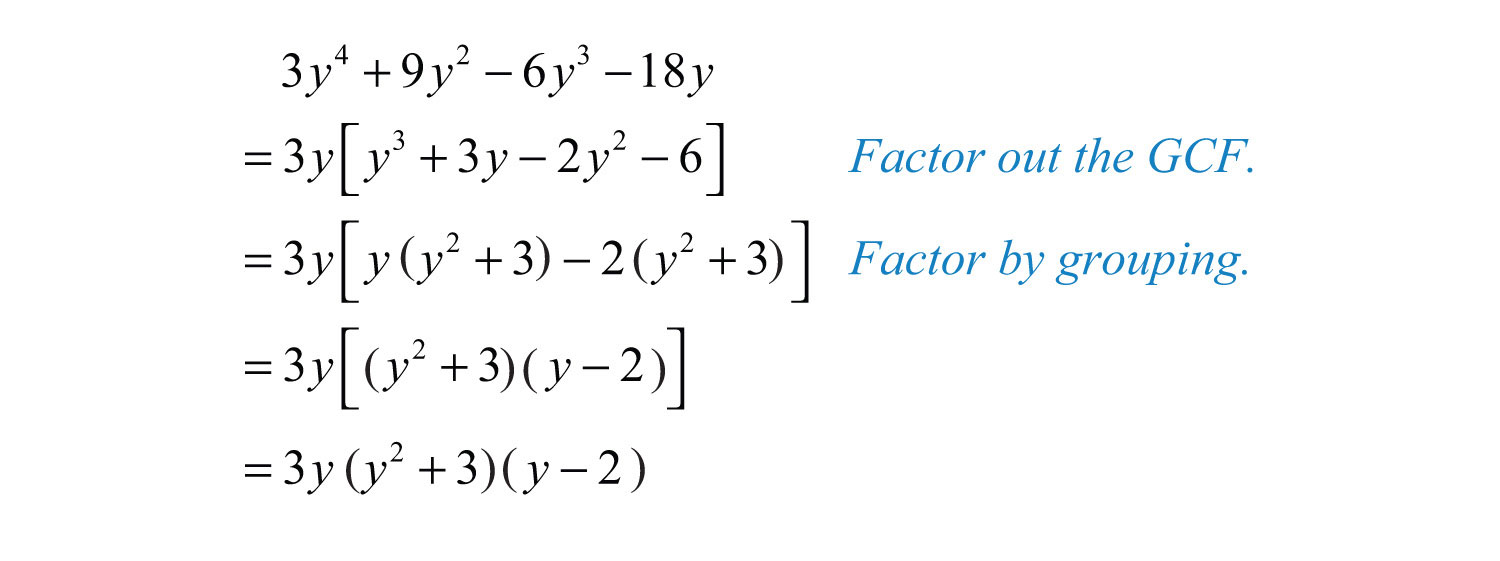Factoring by Grouping
Key Questions
-
Factoring by grouping involves grouping terms then factoring out common factors. Here are examples of how to factor by grouping:
Example with trinomial:
#3x^2 - 16x - 12# , where#ax^2 = 3x^2, bx = -16x, c=-12# .-
To use grouping method you need to multiply
#ax^2# and#c# , which is#-36x^2# in this example. Now you need to find two terns that multiplied gives you#-36x^2# but add to -16x. Those terms are -18x and 2x. We now can replace#bx# with those two terms:
#3x^2 - 16x - 12#
#3x^2 - 18x + 2x - 12# -
Group the expression by two:
#(3x^2 - 18x) + (2x - 12)# -
Factor out GCF in each group:
#3x(x - 6) + 2(x - 6)#
(The binomials in parentheses should be the same, if not the same... there is an error in the factoring or the expression can not be factored.) -
The next step is factoring out the GCF which basically has you rewrite what is in parentheses and place other terms left together:
#(x - 6)(3x +2)# (THE ANSWER)
Example with polynomial:
#xy - 3x - 6y + 18# -
Group the expression by two:
#(xy - 3x) - (6y - 18)#
Careful with the sign outside before parenthesis.. changes sign of the 18. -
Factor out GCF in each group:
#x(y - 3) - 6(y - 3)#
(The binomials in parentheses should be the same, if not the same... there is an error in the factoring or the expression can not be factored.) -
The next step is factoring out the GCF which basically has you rewrite what is in parentheses and place other terms left together:
(y - 3)(x - 6) (THE ANSWER)
-
-

As you can see here we are making the terms inside the box brackets brackets into groups and then we remove the common factors.
finally using the distributive property we write it as a product of 2 binomials.
-
Answer:
Please read below:
Explanation:
When we have a polynomial of the form
#ax^2+bx+c# We can factor this quadratic with splitting up the
#b# term into two terms. This allows us to factor the left side of the expression and the right side individually, and look for a common factor between them. This is factoring by grouping.Let's take our polynomial
#ax^2+bx+c# again. To factor by grouping, we can rewrite this expression as#color(blue)(a)x^2+bx+color(red)(c)=color(blue)ax^2+(color(blue)a+color(red)c)x+color(red)c# Notice that
#(a+c)x# is the same as our#b# term. We can distribute the#x# to both terms to get#color(blue)(ax^2+ax)+color(red)(cx+c)# This is the essence of factoring by grouping. We can look at our polynomial as two groups of two terms.
From the blue terms, we can factor out an
#ax# , and from the red terms, a#c# . This leaves us with#color(blue)(ax)color(purple)((x+1))+color(red)c color(purple)((x+1))# Now, both terms have an
#x+1# in common, so we can factor that out to get#(color(blue)(ax)+color(red)(c))color(purple)((x+1))# We will not always have an
#x+1# term. For instance, take the following polynomial:#3x^2+11x+6# Let's rewrite this as
#color(turquoise)(3x^2+9x)+color(orange)(2x+6)# We can factor a
#3x# out of the blue terms, and a#2# out of the orange terms. We get#color(turquoise)(3x)(x+3)+color(orange)2(x+3)# We can factor an
#x+3# out to get#(3x+2)(x+3)# The key point is that we can rewrite our
#b# term as the sum of two terms so we can factor twice. Next, we look for a common factor between our newly factored expression.Factoring by grouping will not always work- at this point it may be a good idea to resort to the Quadratic Formula.
Hope this helps!
Questions
Polynomials and Factoring
-
Polynomials in Standard Form
-
Addition and Subtraction of Polynomials
-
Multiplication of Monomials by Polynomials
-
Multiplication of Polynomials by Binomials
-
Special Products of Polynomials
-
Monomial Factors of Polynomials
-
Zero Product Principle
-
Factorization of Quadratic Expressions
-
Factor Polynomials Using Special Products
-
Factoring by Grouping
-
Factoring Completely
-
Probability of Compound Events